Lisa Sachs's Blog, page 2
August 30, 2018
The Greatest Escape in Appleton, Wisconsin
Every year we meet our friends, who live in Northern Wisconsin, somewhere halfway in Central Wisconsin for a good, face to face visit. We’ve been friends for so long that even meeting for 24 to 48 hours gives us plenty of time to catch up. This year, we chose Appleton, Wisconsin, a town with a population of 75,000. It’s amazing the things we don’t know about all the places big and small in our country.
As we walked around Houdini Plaza, we found a statue and a plaque dedicated to none other than Harry Houdini, the great escape artist. We were surprised to hear that he was from Appleton and even more surprised to learn that their history museum’s major permanent exhibit was all about him. Since very few museums anywhere have this type of exhibit I was intrigued to see it.
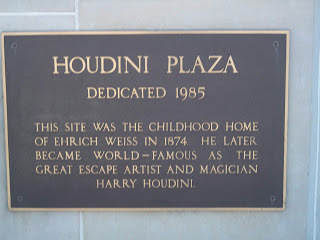
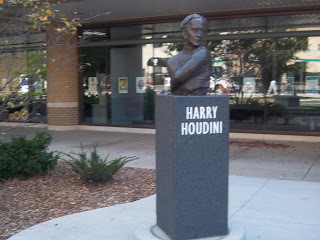
The museum is housed in a castle that was originally a Masonic Temple and is worth seeing in itself.
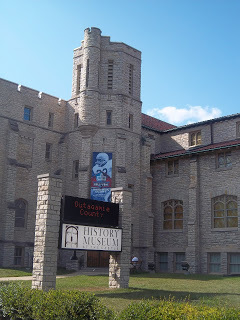
The second floor of the building is devoted to the Harry Houdini exhibit. Harry Houdini was born Erik Weisz in Budapest, Hungary in 1874. He and his family emigrated to America in 1878 ending up in Appleton. His father was employed as the rabbi at the synagogue in Appleton and worked there for four years. He was then let go because the congregation felt that he wasn’t modern enough. This was the first home that Erik/Harry remembers and the city of Appleton seems to have adopted him as a native son.
After Mr. Weisz lost the rabbinate position, the family moved to Milwaukee and then New York where in both places, they lived in extreme poverty. As the oldest of seven children, Erik AKA Harry felt responsible for helping to support his family. He quit school and went to work doing various jobs and then trying for years to make it in Vaudeville as a magician. He got his first break in 1899 when he was recognized in St. Paul, Minnesota and the rest is should we say, history.
Among Harry Houdini’s quotes the one I found most telling was “My chief task has been to conquer fear.” His wife also said that the main challenge for Harry that enabled him to perform all his life-threatening stunts was to conquer all his fears. He later used his celebrity status to advocate for women’s suffrage and to try to expose fraudulent spiritualists who were prevalent at that time.
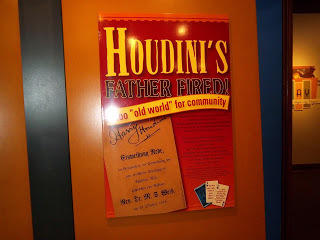
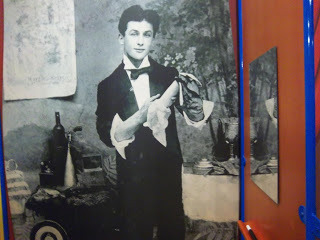
The exhibit in Appleton is mostly devoted to memorabilia about Houdini including some of the equipment he used for his stunts. They do this in a hands-on way giving visitors to the museum the opportunity to try it out. In the back of each stunt display is an explanation of how Houdini managed to accomplished these feats often with sleight of hand and other magician tricks. Altogether it was a very entertaining exhibit and good to go to with children because of the hands-on nature of much of the exhibit. Should you find yourself in Central Wisconsin, this exhibit is certainly worth a visit.
Published on August 30, 2018 07:34
August 16, 2018
Re-visiting the United States One Year Later
A year ago, I turned on my television to watch “Jeopardy!” In the Chicago area, it’s broadcast at 3:30 in the afternoon. This was the first time in weeks that I’d been home at that time to watch it. You can imagine my disappointment when Alex Trebek was preempted because the current occupant of the White House was giving a press conference.
The weekend before, neo-Nazis and white racists had joined forces in Charlottesville, Virginia to march with torches chanting “Jews will not replace us.” Our president had called the press conference to insist vociferously that many people marching with Nazis and the Klu Klux Klan were “fine people.” Worse than that was my realization that more that 62million Americans had voted for him and another 90million had allowed him to win by not voting at all. Although I was born in the United States as were my parents and two of my grandparents, I felt like my country had been taken away from me. I had just become stateless.
 Nazis/white supremacists marching in Charlottesville in 2017Now a year later, I am relieved that only 25 Nazi/racists marched in Washington overpowered by thousands of counter-protesters. The New York Times reports that these bigots are now shying away from marches and organizing more hate in the shadows. America is still on the brink. As of February 26, 2018, the Anti-Defamation League of B’nai B’rith reports that there were 1,986 anti-Semitic incidents in the United States since the election of 2016. The Southern Poverty Law Center is tracking 954 hate groups in the United States. The groups target African-Americans, Jews, Muslims, Mexican-Americans, and people in the LBGTQ community. Both the ADL and the SPLC report that there has been a large spike in hate activity since the 2016 election.
Nazis/white supremacists marching in Charlottesville in 2017Now a year later, I am relieved that only 25 Nazi/racists marched in Washington overpowered by thousands of counter-protesters. The New York Times reports that these bigots are now shying away from marches and organizing more hate in the shadows. America is still on the brink. As of February 26, 2018, the Anti-Defamation League of B’nai B’rith reports that there were 1,986 anti-Semitic incidents in the United States since the election of 2016. The Southern Poverty Law Center is tracking 954 hate groups in the United States. The groups target African-Americans, Jews, Muslims, Mexican-Americans, and people in the LBGTQ community. Both the ADL and the SPLC report that there has been a large spike in hate activity since the 2016 election.In the upcoming elections, five self-avowed Nazis are running for Congress on the Republican ticket. In Illinois, the Governor and regular party people have directed their constituents not to vote for this candidate. Nevertheless, their statements came much too late - after the primary elections. They did not prevail on any party regular to run against this Nazi in the Republican primary and 20,000 people voted for him. While five is a small number – there are 435 Representatives in Congress – it is still pretty frightening. To my knowledge, having five Nazi candidates running as Republicans is unprecedented.
Can we breathe sighs of relief now that the Nazi rally was so poorly attended? I don’t think so. During the 2016 election campaign, T ran a campaign of bigotry. As you all remember, he began his political career with innuendos about Pres. Obama’s citizenship. This was followed by his racist statements about Mexicans. From there, he went on to talk of establishing a registry of Muslims in the United States. His rhetoric and election victory have emboldened a Pandora’s box of hatred to come out and flourish. It’s going to take a lot more than a couple of tweets saying that all Americans must come together to put those ills back in the box. It’s incumbent on every American to resist the forces of hatred and racism as much as we possibly can.
Published on August 16, 2018 06:00
August 9, 2018
Facing the Next Natural Disaster in the Netherlands
We had five days to spend in Amsterdam and wanted to see more of the Netherlands. Delft is only an hour’s train ride from Amsterdam making it a good day trip destination for us.
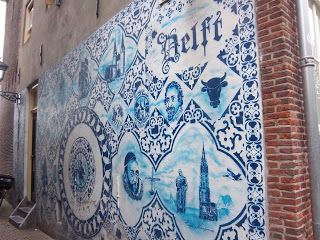
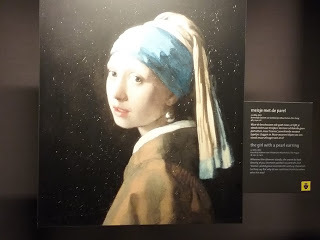
Besides being the home of Delft Pottery and the artist Vermeer of recent Girl with the Pearl Earring fame, Delft is the home of the Institute for Water Education. The Institute is the first noticeable building after leaving the Delft train station. It looked intriguing so we went in hoping to be able to talk to people there. Classes were in session but the woman at the front desk was very happy to tell us about the mission and work of the Institute. It opened in 1953 following a devastating flood in the Netherlands in which the dikes broke and 1836 people died, 70,000 were evacuated, and 500 buildings were totally destroyed.
The Netherlands government resolved to use their resources to study water management in an effort to prevent another flood from happening. They had had a natural disaster but decided not to have another one. Right after the flood, they opened the Institute for Water Education www.un-ihe.org to educate the world about their water management technology. Students come from all over the world especially Third World countries to learn about water management and purification and distribution. Students can earn Masters degrees or Phd’s or take short specifically targeted courses.
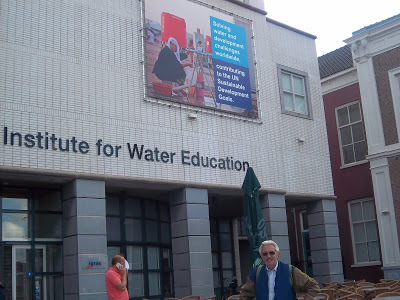
Since 1953, the Dutch have built new dikes, dams, and storm surge barriers. In some places especially Rotterdam, they have adapted to the rising waters of climate change by creating lakes, garages, parks, and plazas that double as reservoirs in times of heavy rain. In Rotterdam, the Maeslant Kering, a huge sea gate, was built that allows water to flow or prevents it from coming in as the situation demands. As a result, since 1953, the Dutch have never suffered a devastating flood again. Just in case, however, their children have to do flood disaster drills where they are taught to swim with their clothes and shoes on. Fortunately, they’ve never had to use this skill.
The Dutch have exported their water management technology to places throughout the world including Wuhan, China, Ho Chi Minh City, Cambodia, Jakarta, Indonesia, Venice, Italy, Sao Paolo, Brazil and to Miami, New Orleans, and New York City in the United States.
On a trip to Canada, we met a Dutch couple from Rotterdam. As we ate breakfast together, the woman said, “I don’t understand the people in Houston. We offered to send them our technology after their hurricane and they didn’t want it. Do they want to have floods every year?”
All that I could do was shake my head. I don’t understand it either.
Published on August 09, 2018 06:00
August 2, 2018
Looking Up to People in Amsterdam
I knew that I was going to have to look up to people when we arrived at our hotel room. In our bathroom, I had to stand on tiptoes to see the mirror. The towel rack was at least a foot over my head. I couldn’t even reach the hook to hang up my towel. Most Dutch people are really tall. At five feet, I had to look up often during our visit there. As our taxi driver told us on our way to the airport, “Yes, we are the tallest people in Europe. That’s been known for years.”
At the Anne Frank House, I found other ways to look up to people. Before going there, we went to beautiful neighborhoods and saw the houseboats on the canals and visited the Van Gogh Museum. For both the Van Gogh Museum and the Anne Frank House, it’s important to buy timed entry tickets on-line about three months before you go to Amsterdam. In fact, at the Anne Frank House it’s the only way that tickets are sold.
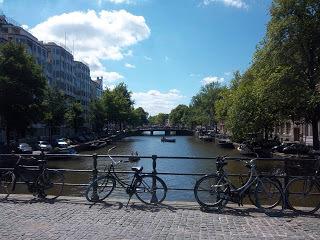
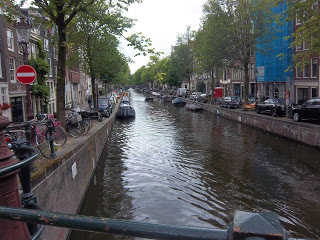
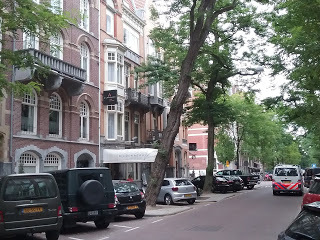
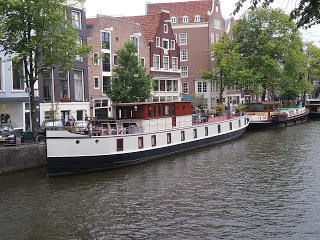
Over a million people visit the House each year and everyone we asked knew where it was. On a walking tour through downtown Amsterdam the previous day, a young Dutch woman told me that all the public schools in the Netherlands are required to teach about the Holocaust and she was anxious to visit the Anne Frank House, also.
On arrival at the Anne Frank House, we were given audio guides in our preferred language to listen to in each room. The house - really Otto Frank’s office - is narrow with steep stairs. A bookcase hiding a door led to the secret sector of the house where the Franks and their friends the Vandamms hid for two years. During the day, they couldn’t look out the window, flush the toilet, or make any noise for fear of being heard and thus, caught and deported.
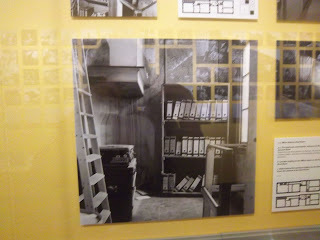 A photograph of the bookcase in front of the door leading to the Franks' hiding placeWhile Anne Frank and her family led an excruciating life for those two years and met a tragic end being deported only a few months before the end of World War II, their helpers also led a dangerous life for those two years. During that time, Miep and Jan Gies, Johannes Voskuijl, Johannes Kleiman, and Victor Kleiman helped them to hide. They brought them food and supplies and did everything they could to keep the families hidden. They did this at the risk of deportation or even death to themselves. Years later when Miep was asked about her heroism, she said, “They asked for my help. How could I do anything else?”
A photograph of the bookcase in front of the door leading to the Franks' hiding placeWhile Anne Frank and her family led an excruciating life for those two years and met a tragic end being deported only a few months before the end of World War II, their helpers also led a dangerous life for those two years. During that time, Miep and Jan Gies, Johannes Voskuijl, Johannes Kleiman, and Victor Kleiman helped them to hide. They brought them food and supplies and did everything they could to keep the families hidden. They did this at the risk of deportation or even death to themselves. Years later when Miep was asked about her heroism, she said, “They asked for my help. How could I do anything else?” Those Dutch Jews who’ve survived or are descendants of survivors feel uncertain. They look at their non-Jewish neighbors and wonder, “Would you hide me now?”
What these people did to hide the Frank family was truly heroic. I have to look up to them and ask myself what I would do in a similar situation. I hope that I would have the courage to do the right thing but until one is up against a situation, it’s all conjecture. As immigrants get deported here in the United States and even naturalized citizens are threatened, I wonder what I would do. In the meantime, I protest against our regime’s immigration policies in the hopes that I’ll never have to find out.
Published on August 02, 2018 06:00
July 26, 2018
Visiting Germany in the Time of Trump
I love river cruising. My husband and I had been on two of them, one on the Danube and one on the Rhone. They were both fabulous trips. I wanted to go on another but most of the others sailed through Germany. I hesitated to go there.
I knew that the German government had atoned for their sins of the Holocaust. I knew that they had been giving reparations to refugees from Germany since the 1960’s. I knew that their children were taught about the Holocaust in all their public schools. I also knew that Germany has some of the strictest laws against hate speech and Holocaust denial. Still I hesitated. I had grown up among too many people with numbers tattooed on their arms and I couldn’t let go of that memory.
Then on August 12, 2017, Charlottesville happened. I watched in horror as neo-Nazis marched through that town carrying torches and chanting “Jews will not replace us.”
Even worse, I watched the President of the United States insist at his news conference that many of the neo-Nazis marching were “fine people.” I felt that my country had abandoned me. Realizing that no country we would visit could be worse than what America was becoming, I was ready to make reservations for another river cruise.
Now that we have come back, I’m really glad that we did this cruise. We started from Basel, Switzerland and stopped in Colmar and Strasbourg, France, ended in Amsterdam and yes, stopped in Breisach, Koblenz, Heidleberg, Rudeisheim, and Cologne all in Germany. The towns in Germany were nothing like what I imagined. I don’t know what I imagined exactly but they were nothing like it.
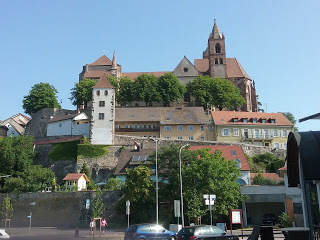 in Breisach
in Breisach
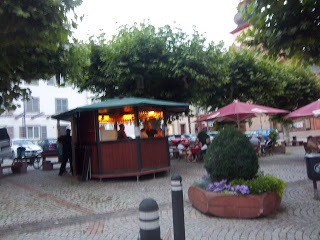 Rudesheim town square
Rudesheim town square
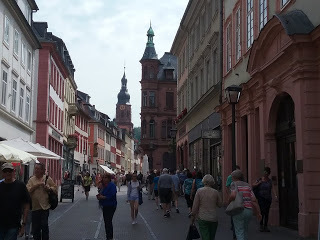 Heidleberg
Heidleberg
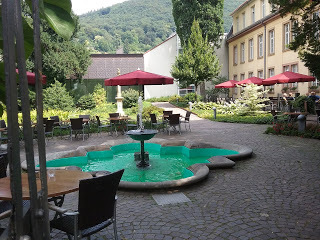 HeidlebergAll the small towns and villages where we traveled were beautiful. Of course, a tour would show off the scenic places. As such, we sailed through the Loreley section of the Rhine in the morning. Designated as a UNESCO world heritage site, it took my breath away.
HeidlebergAll the small towns and villages where we traveled were beautiful. Of course, a tour would show off the scenic places. As such, we sailed through the Loreley section of the Rhine in the morning. Designated as a UNESCO world heritage site, it took my breath away.
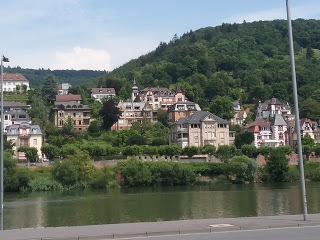 A scene on the RhineIn Cologne, after the cruise’s walking tour, we met up with a German friend whom we had met in the intensive language school in Costa Rica where we had studied Spanish in the winter. We spent the afternoon with her seeing parts of the city away from the tourist areas where residents of Cologne actually spend time. Our friend is a very progressive woman who has experiences living throughout the world and it was great seeing her town through her eyes.
A scene on the RhineIn Cologne, after the cruise’s walking tour, we met up with a German friend whom we had met in the intensive language school in Costa Rica where we had studied Spanish in the winter. We spent the afternoon with her seeing parts of the city away from the tourist areas where residents of Cologne actually spend time. Our friend is a very progressive woman who has experiences living throughout the world and it was great seeing her town through her eyes.
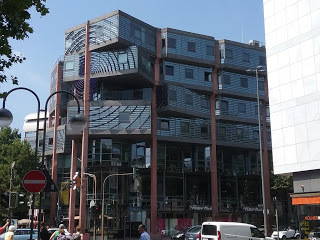 in Cologne
in Cologne
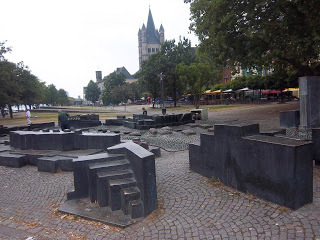 in Cologne
in CologneExcept in Cologne, the only Germans we talked to extensively were the tour guides so I know to take everything that we saw with a grain of salt. One of my German friends here in America reminded me to do that. I had my moments when I saw plaques to the Holocaust and unused synagogues, but I also saw that most cities had Holocaust Museums.
In Cologne, our friend told us that there was some Nazi sentiment in some areas of Germany. There is some of that sentiment in the United States also; five Republican Congressional candidates are running as avowed Nazis and Holocaust deniers in this year’s election. Most Germans seem more aware of history than most Americans are. It was good to see a country that had recovered from Fascism but we know the horrors that happened before that recovery. We have to do whatever we can to make sure that America doesn’t repeat that history.
Published on July 26, 2018 07:44
July 19, 2018
Oh No! The French Have Taken the Statue of Liberty Back!
We were so lucky to be able to take a cruise on the Rhine River from Basel, Switzerland to Amsterdam, the Netherlands. On the second day, we docked in Breisach, Germany. In the morning, we did a walking tour of that lovely village. In the afternoon, we did a bus tour to Colmar, France. We crossed the Rhine by bus - less than a kilometer’s distance - and had thus crossed from Germany into France.
The Alsace region has been fought over by Germany and France over the centuries and has changed nationality several times. Its culture is an interesting blend of the two ethnic groups. About 20% of the population speak the Alsatian dialect. Our local guide, who seemed to be in her 50’s, told us that this dialect can only be taught in the home. It has no written language and she is probably in the last generation to speak it. This would be tragic because when a language – or dialect – dies, some of the culture dies with it.
Our first stop in Colmar was the Statue of Liberty. What first came to my mind was that the French had taken it back, deciding that we no longer deserved to keep it. While current American immigration policy makes this true, we were only viewing a replica. It was put there by the village of Colmar in honor of their native son, Frederic Auguste Bartholdi who was born in Colmar on April 2, 1834 and designed the statue that up until now has been a symbol of America’s welcoming of immigrants from throughout the world. It was a poignant moment for me to see that symbol of freedom and know that it no longer expressed the values that made America truly exceptional.
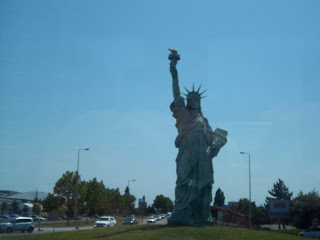 replica of the Statue of Liberty at the entrance of ColmarNext, we went into the center of Colmar. It was founded in the ninth century and much of its style has been retained. Its dramatic pitched roofs, pastel stucco and distinct French shutters with geraniums in all the window boxes make it a unique place to visit. Its Little Venice is something special to see.
replica of the Statue of Liberty at the entrance of ColmarNext, we went into the center of Colmar. It was founded in the ninth century and much of its style has been retained. Its dramatic pitched roofs, pastel stucco and distinct French shutters with geraniums in all the window boxes make it a unique place to visit. Its Little Venice is something special to see.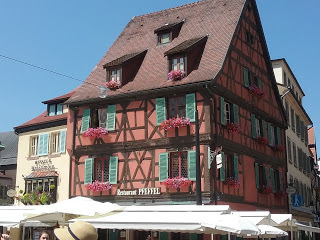 good example of Colmar building
good example of Colmar building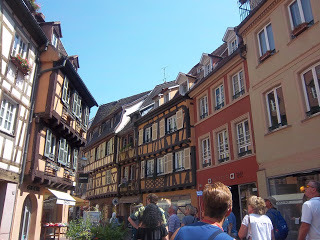 a street in Colmar
a street in Colmar
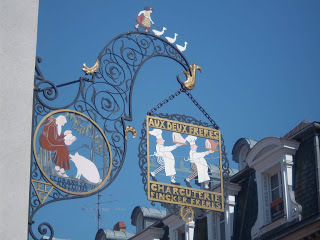 a typical sign
a typical sign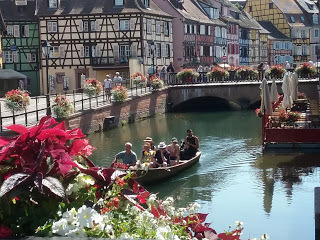 in Little VeniceI would have loved to stay longer and visit Colmar’s museums and other points of interest, but it was onward to a wine tasting. Colmar is in the center of the Alsatian wine region. The area has a special micro-climate perfect for growing grapes. The area is noted for its Pinot Blanc, Riesling, Pinot Gris, and several others. I’m no connoisseur of wine so they all tasted good to me. To go with it, this family winery served a kuglehopf, a cake typical of Alsace that went very well with the wine. Our guide told us that she has no time to cook Alsatian dishes and only eats them at her mother’s house. I told her to learn these recipes before it’s too late. When a culture loses its language and cuisine, what else is left?
in Little VeniceI would have loved to stay longer and visit Colmar’s museums and other points of interest, but it was onward to a wine tasting. Colmar is in the center of the Alsatian wine region. The area has a special micro-climate perfect for growing grapes. The area is noted for its Pinot Blanc, Riesling, Pinot Gris, and several others. I’m no connoisseur of wine so they all tasted good to me. To go with it, this family winery served a kuglehopf, a cake typical of Alsace that went very well with the wine. Our guide told us that she has no time to cook Alsatian dishes and only eats them at her mother’s house. I told her to learn these recipes before it’s too late. When a culture loses its language and cuisine, what else is left?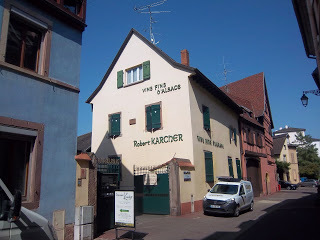 the wineryHaving these regional cultures enriches a nation and it would be tragic to lose it.After Colmar, we spent the next day in Strasbourg about 70 miles away. Besides being a government center for the EU, it is also a center of Alsation culture. It’s an area well worth visiting. I feel so fortunate to have been there.
the wineryHaving these regional cultures enriches a nation and it would be tragic to lose it.After Colmar, we spent the next day in Strasbourg about 70 miles away. Besides being a government center for the EU, it is also a center of Alsation culture. It’s an area well worth visiting. I feel so fortunate to have been there.
Published on July 19, 2018 07:45
June 14, 2018
A Child of the Cold War Views the Singapore Summit
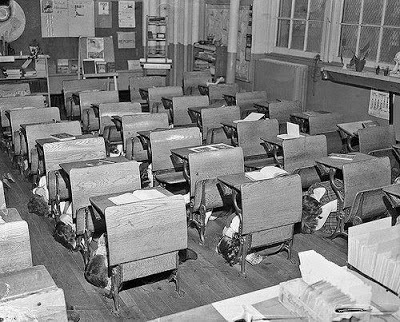 A Typical 1950's Air Raid Drill
A Typical 1950's Air Raid DrillIt happened a few times per school year. The siren sounded and we were told to crouch under our desks with one hand behind our head and the other hand in front of it. This action would protect us in the case of a nuclear attack. The literature always predicted the damage that would be done should Times Square be bombed. The radius would be huge and we in the New York suburbs would be affected. People built fallout shelters in their backyards. I had nightmares several times per month.
In 1960, I went with my mother to a demonstration at the Soviet Union’s embassy across from the United Nations to protest above ground nuclear testing. The ambassador invited us in and said, “Welcome to the territory of the Soviet Union.”
We were so imbued with Cold War rhetoric that I panicked for a moment hearing that and don’t remember a word of his speech after that.
The air raid drills continued throughout my high school years. The survivors of Hiroshima and Nagasaki were still alive to tell us how devastating a nuclear war could be. Nevertheless, compared to the threat now, this threat was mild. Leaders on both sides knew what the risks were and most of them had some degree of sanity. The weapons of mass destruction were weaklings compared to what is available now and nuclear proliferation hadn’t happened yet. Most of us knew that there could be no survivors of a nuclear war.
We had an air raid drill in my high school in which we had to go out in the hallway. I held up a homemade sign that said, “The only shelter is peace.” I was sent to the assistant principal’s office to be disciplined. Since this was my first offense of any kind, I was questioned about what I was doing and sent back to class. The nightmares continued.
My parents were active in the Committee for a Sane Nuclear Policy - popularly known as SANE - and I enjoyed telling my friends that my parents were in Sane. We drank powdered milk for fear of the Strontium 90 that was present in milk from nuclear fallout of the tests. Nothing could be done to that powdered milk that could make it taste even remotely drinkable so drinking that stuff for three years until the Nuclear Test Ban Treaty of 1963 was signed was a trauma in itself.
The memories of living through the cold war are with me still. Hearing the threats of Kim Jong Un and the uncontrolled threats and irrational menacing of our current President bring it all back. Unfortunately, the threat now is worse. We have a President who listens to advice from no one seeming to make decisions based on his emotions and instincts of the moment. Kim Jong Un is a ruthless totalitarian dictator who seems just as irrational.
The news that our current President and Kim Jong Un would meet brought momentary relief. Now that news is emerging from this summit, I don’t think that feeling will last. Apparently, he has made concessions to North Korea without receiving any in return. Time will tell. Although I disagree vehemently with virtually everything our President says and does, I wish him success in this endeavor. The alternative is unthinkable.
Published on June 14, 2018 06:00
June 7, 2018
Must See Chicago, the City of the Bad Rap
Must See Chicago, a walking tour given by the Chicago Architecture Foundation (CAF) www.architecture.org, highlights some of the best Chicago architecture from its many architecture periods. I’m really glad that they’re giving this tour to highlight some of the best that Chicago has because this city deserves a much better reputation than it has.
When we lived in Israel in the 1970’s, my husband would tell people he was from Chicago and they’d invariably make a gun sign with their hands and say, “Al Capone, bang, bang.” I learned after a short time that that was the reaction people had to Chicago about 99% of the time. It got better for a few years when people associated Chicago with Michael Jordan and then President Obama. Unfortunately, that respite was short-lived.
In recent years, Chicago is again associated with gun violence and murders. When we travel outside the Unite States now, people ask us if we’re planning to move soon from our dangerous city. What most people don’t see is how many beautiful things there are in Chicago. I tell them that most tourist areas don’t see any of the violence and that tragically, the violence involves a small segment of the population. The economic and social inequities that give rise to this are the subject of many other posts and shouldn’t be minimized. Nevertheless, the beauty of the city shouldn’t be negated either.
The CAF does a great job of showing off some iconic Chicago buildings and giving people a great overview of downtown Chicago. We took the Must See Chicago tour on a beautiful sunny day and so it was especially enjoyable. And because the pictures speak for themselves, here are a few.
 The Wrigley Building, completed in 1924
The Wrigley Building, completed in 1924
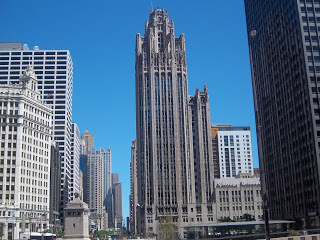 The Tribune Tower, completed in 1925
The Tribune Tower, completed in 1925
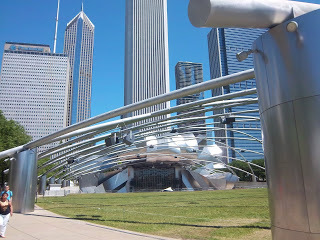 The Jay Pritzker Pavillion in Millenium ParkChicago has been providing free concerts several times per week during the summer months for over 80 years. This is the newer band shell and the acoustics are fabulous.
The Jay Pritzker Pavillion in Millenium ParkChicago has been providing free concerts several times per week during the summer months for over 80 years. This is the newer band shell and the acoustics are fabulous.
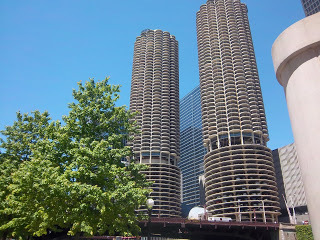 Marina City, opened in 1968This mixed use apartment building brought people from the suburbs back to the city where they could live near their work.
Marina City, opened in 1968This mixed use apartment building brought people from the suburbs back to the city where they could live near their work.
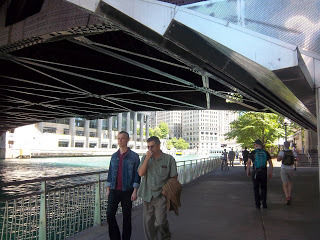 along the Chicago Riverwalk
along the Chicago Riverwalk
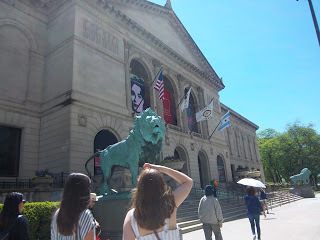 the Chicago Art Institute
the Chicago Art Institute
 the Chicago Cultural Center, formerly the main libraryThis is a phenomenal building. It was opened in 1897, one of the first free open public libraries in the United States. The collection became too big and the main library was moved to the Harold Washington Library. This building besides having beautiful mosaic ceilings houses many free cultural events including art exhibits and weekly noontime concerts. Visit Chicago and you'll see many more beautiful things. You won't be sorry you came.
the Chicago Cultural Center, formerly the main libraryThis is a phenomenal building. It was opened in 1897, one of the first free open public libraries in the United States. The collection became too big and the main library was moved to the Harold Washington Library. This building besides having beautiful mosaic ceilings houses many free cultural events including art exhibits and weekly noontime concerts. Visit Chicago and you'll see many more beautiful things. You won't be sorry you came.
When we lived in Israel in the 1970’s, my husband would tell people he was from Chicago and they’d invariably make a gun sign with their hands and say, “Al Capone, bang, bang.” I learned after a short time that that was the reaction people had to Chicago about 99% of the time. It got better for a few years when people associated Chicago with Michael Jordan and then President Obama. Unfortunately, that respite was short-lived.
In recent years, Chicago is again associated with gun violence and murders. When we travel outside the Unite States now, people ask us if we’re planning to move soon from our dangerous city. What most people don’t see is how many beautiful things there are in Chicago. I tell them that most tourist areas don’t see any of the violence and that tragically, the violence involves a small segment of the population. The economic and social inequities that give rise to this are the subject of many other posts and shouldn’t be minimized. Nevertheless, the beauty of the city shouldn’t be negated either.
The CAF does a great job of showing off some iconic Chicago buildings and giving people a great overview of downtown Chicago. We took the Must See Chicago tour on a beautiful sunny day and so it was especially enjoyable. And because the pictures speak for themselves, here are a few.
 The Wrigley Building, completed in 1924
The Wrigley Building, completed in 1924 The Tribune Tower, completed in 1925
The Tribune Tower, completed in 1925 The Jay Pritzker Pavillion in Millenium ParkChicago has been providing free concerts several times per week during the summer months for over 80 years. This is the newer band shell and the acoustics are fabulous.
The Jay Pritzker Pavillion in Millenium ParkChicago has been providing free concerts several times per week during the summer months for over 80 years. This is the newer band shell and the acoustics are fabulous. Marina City, opened in 1968This mixed use apartment building brought people from the suburbs back to the city where they could live near their work.
Marina City, opened in 1968This mixed use apartment building brought people from the suburbs back to the city where they could live near their work. along the Chicago Riverwalk
along the Chicago Riverwalk
 the Chicago Art Institute
the Chicago Art Institute the Chicago Cultural Center, formerly the main libraryThis is a phenomenal building. It was opened in 1897, one of the first free open public libraries in the United States. The collection became too big and the main library was moved to the Harold Washington Library. This building besides having beautiful mosaic ceilings houses many free cultural events including art exhibits and weekly noontime concerts. Visit Chicago and you'll see many more beautiful things. You won't be sorry you came.
the Chicago Cultural Center, formerly the main libraryThis is a phenomenal building. It was opened in 1897, one of the first free open public libraries in the United States. The collection became too big and the main library was moved to the Harold Washington Library. This building besides having beautiful mosaic ceilings houses many free cultural events including art exhibits and weekly noontime concerts. Visit Chicago and you'll see many more beautiful things. You won't be sorry you came.
Published on June 07, 2018 06:00
May 24, 2018
Imagining World Peace At the Skokie Festival of Cultures
America pulling out of the Paris Accord [on climate change]. America ending its participation with the Iran treaty on nuclear weapons. A threatened end to America’s social safety net. The news is so horrific these days that I feel exhausted from it and needed a break. Fortunately, I got it at the 28th Annual Skokie Festival of Cultures this past weekend.
 Flags representing all the participating countriesSkokie, a Chicago suburb of about 70,000 people, is home to people from around the world. About 55% of its residents speak a native language other than English; over 70 languages are spoken here. Every year Skokie’s diversity is not just tolerated. Rather it’s embraced. This year 40 communities participated.
Flags representing all the participating countriesSkokie, a Chicago suburb of about 70,000 people, is home to people from around the world. About 55% of its residents speak a native language other than English; over 70 languages are spoken here. Every year Skokie’s diversity is not just tolerated. Rather it’s embraced. This year 40 communities participated.The Skokie Festival of Cultures takes place on the third weekend of May each year. We chose the better of the two days – at least it wasn’t raining – to attend. We visited the booths meeting people this year from Ireland, Azerbaijan, Bulgaria, Bangladesh, Iraq, Uzbekistan, Sweden, Guatemala, and Korea. People displayed their folk arts and artifacts and talked about their countries to whoever stopped by their booths. We had been blessed to travel to a few of those countries and told the people at each booth about our trips. They were interested in hearing our impressions and we had some nice conversations.
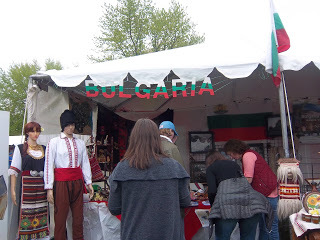 At the Bulgarian Booth
At the Bulgarian Booth
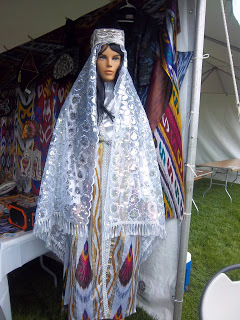 At the Uzbekistan Booth
At the Uzbekistan Booth
 At the Iraqi BoothThen it was on to the pavilion to see the dancing and singing. This year we saw dancers from West Africa and Korea. Beautiful performances. Then it was on to an Indian Holi celebration. This festival of colors is observed each spring in India to celebrate a good harvest as well as the victory of good over evil. People throw colorful paints at each other in a festival of all different hues. I had seen this on television but never in person. As usual in Skokie, people from all different backgrounds wanted to participate. A line was formed to get one’s tee shirt to wear to protect one’s clothes. While not quite as colorful as it is in India, it was certainly joyous.
At the Iraqi BoothThen it was on to the pavilion to see the dancing and singing. This year we saw dancers from West Africa and Korea. Beautiful performances. Then it was on to an Indian Holi celebration. This festival of colors is observed each spring in India to celebrate a good harvest as well as the victory of good over evil. People throw colorful paints at each other in a festival of all different hues. I had seen this on television but never in person. As usual in Skokie, people from all different backgrounds wanted to participate. A line was formed to get one’s tee shirt to wear to protect one’s clothes. While not quite as colorful as it is in India, it was certainly joyous.
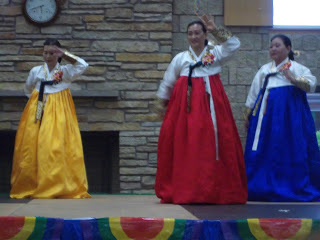 Korean Dancers
Korean Dancers
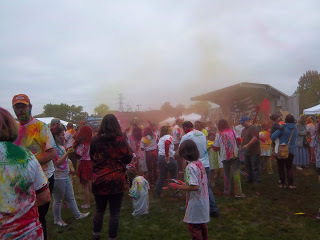 Holi FestivalAnd so now people have shared their songs and dances, their celebrations, and their foods. We are no longer strangers to one another and we can spend another year learning from each other about our respective cultures. If only the rest of the world would learn from Skokie’s experience, the world would be a lot more peaceful. In the meantime, we look forward to next year's Festival of Cultures and the around the world trip in one day that is always so much fun.
Holi FestivalAnd so now people have shared their songs and dances, their celebrations, and their foods. We are no longer strangers to one another and we can spend another year learning from each other about our respective cultures. If only the rest of the world would learn from Skokie’s experience, the world would be a lot more peaceful. In the meantime, we look forward to next year's Festival of Cultures and the around the world trip in one day that is always so much fun.
Published on May 24, 2018 06:00
May 10, 2018
Not Too Late to Advocate for the ERA
“Equality of rights under the law shall not be denied or abridged by the United States or any state on account of sex.” For reasons beyond my understanding, the state of Illinois has never been able to ratify these 24 simple words. If Illinois does ratify the ERA, it will be 35 years late.

This Monday, saying “Better late than Never” and hoping that Illinois would finally get it right, I got on the El Monday, May 7th to attend the Hearing of the human rights committee of the Illinois House on SJRCA4.
The Illinois Senate had passed SJRCA4, the bill that would have Illinois ratify the federal ERA. An ERA for the state of Illinois has been part of the state constitution since 1970. The bill is now before the House. I needed to witness the state of Illinois making history at long last. After all, Abigail Adams had beseeched her husband John Adams to “remember the ladies” in a letter to him on March 31, 1776. They didn’t listen to her and women have been omitted from the Constitution ever since. It was about time.
What I witnessed, however, was probably not Illinois making history but rather reliving it. The room of viewers was packed predominantly with proponents of the ERA. Four panels of witnesses – twenty altogether – had the opportunity to tell the members of the House human rights committee what their opinions were regarding the ERA and about their life experiences that pointed to its necessity. Sixteen people testified in favor and four testified against it.
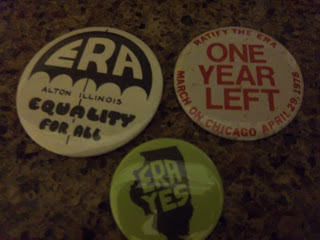
The arguments were the same as they had been in the 1970’s. Rep. Lou Lang, chief sponsor of the bill, started off presenting cogent arguments. The state and federal government needed to ratify the ERA to protect women’s rights. At present, the only right for women delineated in the Constitution is the right to vote. Laws passed which give equal rights to both sexes can be repealed at any time. The opposition gave the same old arguments: that the ERA would lead to more abortions, unisex bathrooms, and a groundswell of boys demanding to play on girls’ high school LaCrosse teams. The ERA states nothing about any of those issues.
After each panel, the House members were able to ask the panelists questions. One house member Mary Flowers asked the same questions to each panel member after a tirade about how the ERA would not specifically protect women of color. Each panel member explained how it would protect all American women but wouldn’t explicitly protect women of color from racist discrimination. The bill is about sex, not race. The vociferousness with which Ms. Flowers presented her arguments suggested to me that some behind the scenes horse trading to which the public was not privy was most likely going on. The failure of the Illinois House to make some bargain was what doomed the ERA to failure in Illinois in the 1970’s.
I hope that I wasn’t seeing Illinois history repeat itself. At this writing, a hearing in Springfield in the Illinois House is in process. There’s still time to call your representatives and tell them to vote YES. All of us American women – white, black, Asian, Latina, native American, pink, green, or whatever – deserve better. It’s about time.
Published on May 10, 2018 07:37



